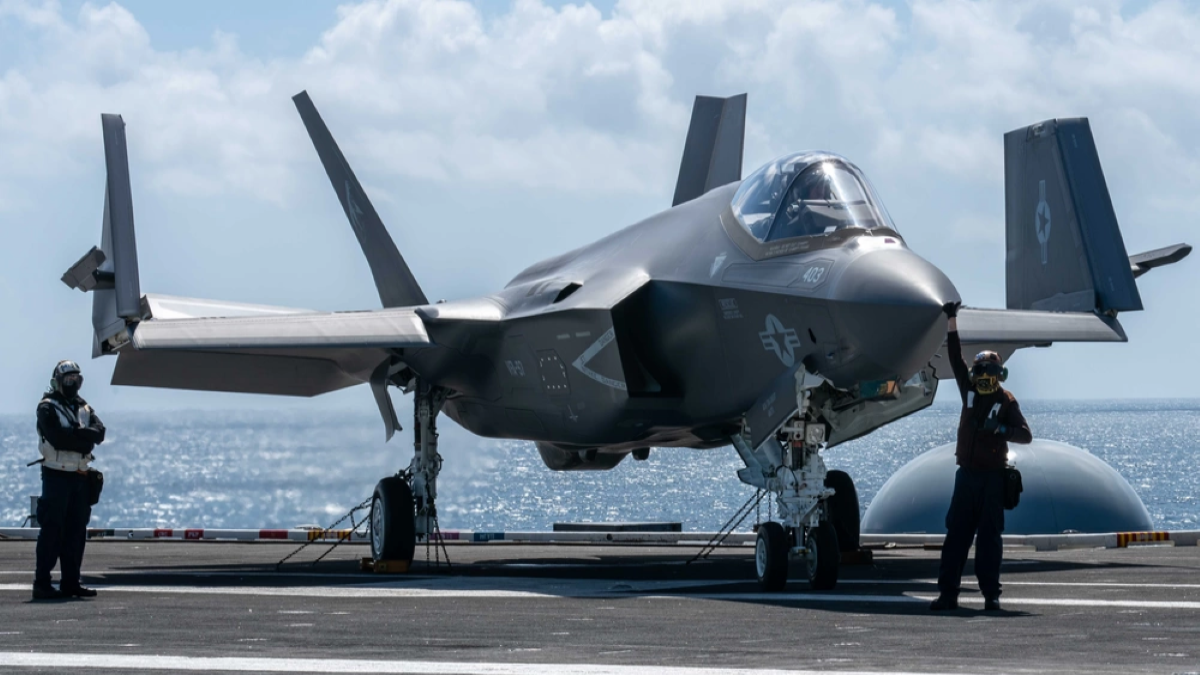Can the U.S. military actually protect our country? We should all have serious doubts.
A few years ago there were troubling signs when the Iranian navy captured two U.S. Navy command boats and ten sailors; a U.S. Army tank crew finished in fourth place, behind Germany, Denmark, and Poland, in a North Atlantic Treaty Organization tank “rodeo;” and when “whistleblowers” admitted that an unacceptable number of U.S. aircraft were not airworthy and lacked capable mechanics, spare parts, and even the pilots necessary to fly them.
More disconcerting and recent are the U.S. Navy’s extraordinary construction woes in what has become the most expensive aircraft carrier in the world, the U.S.S. Gerald Ford. The designers abandoned the time-proven cable system for the carrier’s elevators, the steam-driven aircraft catapult, and the hydraulic-engine arresting system in favor of electromagnetic systems.
As with many “adaptive technologies,” they are great when they work; however, the Ford’s sea trials have been ongoing for years without all of these vital functions performing reliably, and the ship’s full deployment is not expected until 2024.
How did the U.S. military let itself get into this situation? In short: arrogance, ignorance, and incompetence.
A Brief History of U.S. Military Power
The United States developed and deployed the atomic bomb in Japan in 1945 to end World War II. Believing such weapons would be the ultimate deterrent, the United States ramped up its nuclear arsenal and enhanced its aircraft and missile delivery systems. After the Soviet Union’s collapse, the United States stood alone as the world’s superpower.
President Richard Nixon opened the door in 1971 to China, which began the latter’s policy of “state-run capitalism.” This set the stage for China’s slow evolution into a world power.
Three subsequent unconnected historic events from 1990 to 2001 combined to degrade the U.S. military’s strategy, force deployment, weapons development, and funding. First, in 1990, the U.S. Congress, under George H.W. Bush, enacted the Base Realignment and Closure Act (BRAC). That initiated a series of assessments through the mid-2000s aimed at cost savings while attempting to maintain overall military readiness.
Second, in 2000, President Bill Clinton threw the door to China wide open by signing the China Trade Bill. Among other things, it led to obvious financial incentives for U.S. companies to invest in China and partner with China’s designated oligarchs.
Third, the September 11, 2001 terror attacks on the World Trade Center and Pentagon proved to be watershed events for the U.S. military, strategically and financially. The futile hunt for weapons of mass destruction resulted in the military spending two decades in the Middle East involved in conventional warfare that morphed into nation-building.
Idealistic Policies Hit the Real World
While BRAC commenced, communities with elected officials that possessed the greatest political influence were, in many cases, more successful in retaining their facilities. This resulted in base closures and force relocations that were not necessarily consistent with maintaining optimal overall military readiness and effectiveness.
Simultaneously, U.S. companies began taking advantage of the China Trade Bill and invested heavily in manufacturing operations there, resulting in disinvestment in the United States and eventually contributing to a trade imbalance favoring China that rose to more than $400 billion a year. Much of that surplus enabled China to build its military.
China’s build-up occurred as the U.S. military response to the 9/11 terror attacks reoriented its primary military focus toward the Middle East and away from longer-term global threats. This also added trillions of dollars to the national debt. In hindsight, it appeared that U.S. political and military “leaders” had taken their eye off the ball that was China.
While the U.S. Distracted Itself, China Arose
After the Cold War victory, the United States appeared to assume its military superiority would go on forever, even as total troop numbers declined from about 3.5 million during the Vietnam era to the current level of about 1.3 million. Meanwhile, China’s military was growing in personnel, advancement of armaments and technology, and, perhaps more importantly, strategy.
The nation’s leaders took the long view by pursuing cyber warfare, artificial intelligence, and payload delivery systems. China also reinforced and expanded its presence in the South China Sea by building artificial islands to accommodate new air and naval bases for their conventional forces. As American taxpayers continued to fund the U.S. military budget and to purchase goods “Made in China” they were, in effect, contributing to China’s trade surplus, which helped fund the rise of the Chinese military.
U.S. leaders also enhanced China’s military position when, in 2013, President Obama and Congress played a game of chicken in the form of budget sequestration. This led to automatic, across-the-board budget cuts to the U.S. military budget. This caused reductions to military personnel, materiel, and force deployment and slowed the technological advancements of U.S. strategic programs and weaponry.
In an attempt to make up for sequestration, President Trump increased military spending annually by more than $200 billion; however, it may have been too little, too late. The greater funding did enable the U.S. military to play catch-up in some fundamental areas, like restoring munitions levels, maintaining and refurbishing aircraft and ships, and setting aside funds for updating the nuclear arsenal. Yet some tangible results would not be realized for a decade. Although subject to a great deal of criticism, Trump also had the foresight to propose, establish, and fund the Space Force to prepare the United States to compete with China in an emerging battleground.
Is the U.S. Military Ready to Defend and Serve?
So, with the above 75-year summary in mind, what is the real status of the U.S. military? Our “leaders” continue to provide assurances that the United States remains the world’s leading military power. This was true immediately after WWII and the Cold War.
Yet, given the progress of our primary military rival since then, contrasted with the fatigue, materiel depletion, development of weapons systems the military did not even want or were too expensive to operate, force deployment, and funding reductions, it is inconceivable that our elected or appointed “leaders” can continue making statements about U.S. military superiority with any real confidence and expect to be believed. This can only be due to their undying arrogance.
While the U.S. military “brain trust” was making improvements to night-vision optics, armored personnel carriers, single-purpose jet fighters and bombers and “next generation” aircraft carriers that cannot reliably lift aircraft and armaments to the flight deck, launch the aircraft, or arrest aircraft upon landing, China developed a larger and better equipped standing army; a larger operational navy, including carriers that actually function; and an expanded infrastructure that increases its potential control of islands and countries abutting the South China Sea. Perhaps most ominous was China’s progress in hypersonic missile development and aircraft flown by artificial intelligence.
The Facts Are Ominous
There are numerous reports that while the U.S.S. Gerald Ford won’t be fully operational until at least 2023, China has already developed hypersonic missiles that could destroy the Ford today, with little or no warning. While the United States has developed piloted, multiple specialty aircraft, war gaming indicates China’s comparable planes, flown by AI, will beat piloted aircraft every time.
China has strategically positioned itself for eventual control of the South China Sea with the ultimate prize of netting Taiwan, and the United States is in no position to capably defend Taiwan in any way that would not lead to an embarrassing defeat of our military. Published reports indicate the outcome of every gaming scenario has China prevailing.
Lastly, China has apparently developed its hypersonic missile program to the point that they are nuclear-capable and their paths can be controlled in a low-earth orbit to hit very close to their targets. Remarkably, the U.S. intelligence community admitted they “did not see this coming.”
Even worse, it was subsequently disclosed that a nuclear-equipped hypersonic missile exploding over the United States could create an electromagnetic pulse (EMP) that would effectively destroy the nation’s electrical grid, which our “leaders” have failed to harden. Such an attack would immediately put us back into the mid-1800s, possibly causing more than 300 million Americans to eventually perish.
Presiding over this state of affairs can only be chalked up to ignorance or incompetence, or both. U.S. “leaders” have enabled China to fund the rise of its military via the trading relationship they initiated and fostered, while presiding over the decline of ours.
Americans Should No Longer Feel Secure
Americans should no longer feel secure. As China was in the final stages of proving that it could guide a hypersonic missile to the other side of the globe and hit a target, our “woke” secretary of defense ordered a two-month “stand down” of the entire U.S. military in order to investigate and “root out” white supremacists within its ranks—a waste of precious time chasing a non-existent “domestic enemy.” At the same time, they were expressing pride at new flight suits designed for pregnant pilots, versus aggressively recruiting and training the at least 2,000 new pilots desperately needed to execute the Air Force’s most fundamental mission.
Since these developments have become more widely known, many Americans are no longer buying what their “leaders” are selling with our military. Contrary to an old saying, ignorance is not bliss. We have every right to believe the U.S. military is just not up to the job of defending us, or anyone else, against China.
If Taiwan becomes “one” with China, China will control 70 percent of the world’s microchip production, 70 percent of the mining and 90 percent of the rare earth elements; and up to 90 percent of certain medications, many life-sustaining. That could make China the world’s superpower, and the United States its serf.









